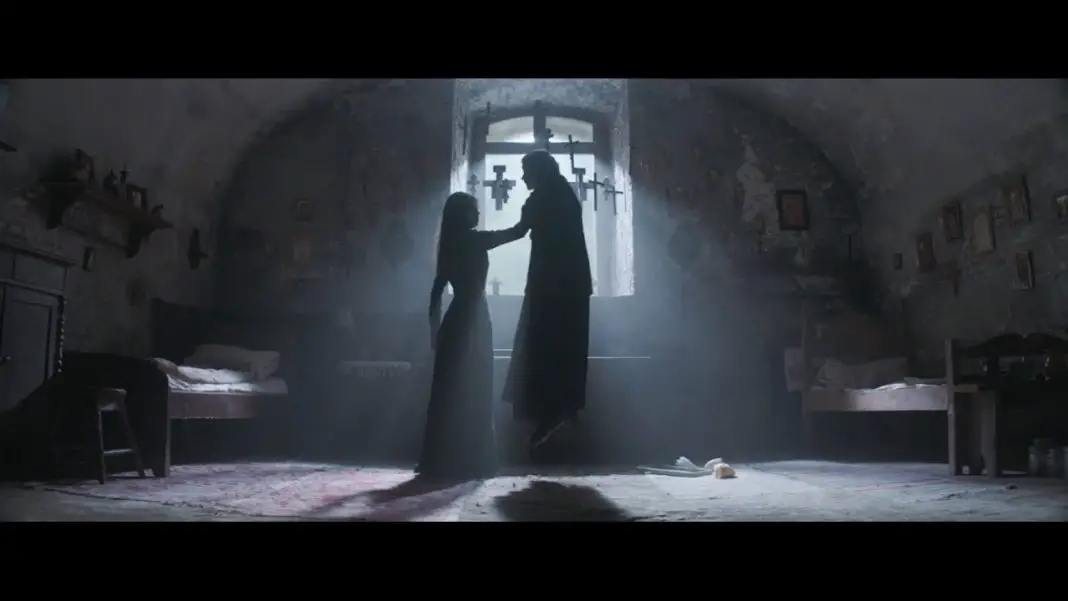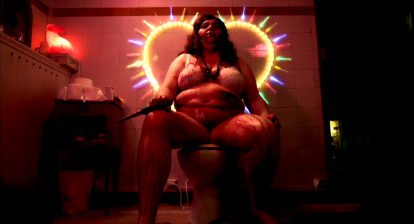It’s hard to overstate how much film—horror films especially—changed at the end of 1973 with the release of The Exorcist. Lines spanned for blocks outside of theater doors. People were vomiting and passing out in cinemas. My father warned me, before I watched it for the first time in 2014, that some people actually needed therapy after seeing it. I didn’t expect it to live up to that hype. How could any movie? But it did. That makes it easy to see why so many movies still try to reproduce that formula: An innocent person is possessed, their symptoms escalate, and tthey’re either saved or killed by the priest(s) that attempt to exorcise them. Some descedants have added a few wrinkles, but for the most part, the possession genre follows The Exorcist’s blueprint. The Crucifixion does as well, going as far as having have Corneliu Ulici’s Father Anton explain the four steps of an exorcism—this structure—to Sophie Cookson’s Nicole Rawlins.
The Crucifixion makes two major alterations. The first is, it takes the story out of America, and into Romania, which gives the movie two great strengths. The landscape is beautiful. Early on there’s a fantastic overhead shot of Rawlins driving down a road that slaloms through a forest. Later she walks through an absolutely gorgeous garden with Bishop Gornik (Matthew Zajac). Director Xavier Gens makes use of the darker elements of Romania as well, filming inside and outside of run down churches with empty gray-brick walls.
It helps that Rawlins doesn’t speak the language. Gens chooses to leave the audience out of the loop as well. The movie opens with the end of the titular crucifixion. The entire scene is shot in Romanian and Latin, without subtitles. It’s a jarring effect the movie uses to help the viewer share Rawlins’ disorientation and confusion.
The second alteration is the frame. The movie follows Rawlins, a reporter who’s coming after the exorcism is complete, rather than Sister Adelina Marinescu (Ada Lupu), who died being exorcised at the start of the movie. The viewer almost immediately knows that Adelina is dead, so the question of whether or not the innocent girl will survive is gone. That tension, which typically drives a possession movie, is gone. It’s replaced with a dialectical approach to faith. The movie shows Rawlins—an atheist whose editor accuses her of pursuing at the story as “Another chance for you to nail faith to the wall”—trying to prove that the priest who performed the exorcism is a madman and a murderer and that Adelina wasn’t possessed. Done masterfully, this could’ve made for a great movie. Unfortunately, it doesn’t live up to that premise and tries to make up the ground through meaningless jump scares.
The special effects are both good and bad. The makeup on Adelina throughout the phases of her possession is excellent. The artists create impossibly purple veins that bulge out of Adelina’s pale neck. They make her eyes pure black as she spouts guttural demonic phrases. They make it feel real as the camera follows a brown liquid from a nurse’s syringe into an IV tower, down the tube, and up the veins in Adelina’s arm. Unfortunately, the computer generated effects aren’t close to the same quality as the practical FX work. There is a scene where a black widow spider crawls out of Adelina’s nose, but the rendering takes something that should be absolutely terrifying and ruins it. The spider shines, obviously fake. It skitters quickly out of the shot. The poor image quality probably dictated the fast exit, but it leaves no time for the viewer to be revolted. It should’ve been cut altogether, as should the other spider scenes.
The script, penned by The Conjuring and The Conjuring 2 scribes Chad Hayes and Carry W. Hayes, is bulky in places, replacing character development with expositive dialogue. When Rawlins asks to write the story, her editor says, “It won’t bring your mother back.” Cookson does her best to inject gravitas into the moment, but its clear the editor is speaking for the audience’s benefit, not hers. His character is inconsistent. He seems to resist the idea of her writing the story in the first place, but then pays to fly her from New York to Romania and stay in a hotel on the off chance the story might be good. What’s working the least though is Rawlins’ attempts to prove that there was no possession. She spends much of the movie’s run-time arguing with priests who believe it was a legitimate possession instead of getting more information from the doctors and Bishop who believed it wasn’t. She doesn’t ever speak persuasively, or authentically, about her atheism. Like The Exorcist before it, The Crucifixion puts its religious beliefs in the forefront and tries to scare the viewer into faithfulness. The Crucifixion sets up a strawman in Rawlins, though, an atheist without teeth or the ability to defend herself. She falls easily back into faith, proving nothing to no one.
WICKED RATING: 4/10
Director(s): Xavier Gens
Writer(s): Chad Hayes and Carry W. Hayes
Stars: Sophie Cookson, Corneliu Ulici, Brittany Ashworth, Matthew Zajac
Release: December 5th (DVD, Digital HD, and Blu)
Studio/ Production Co: Motion Picture Capitol, Ponzan Film Group
Language: English
Length: 90-Minutes
Sub-Genre: Possession



